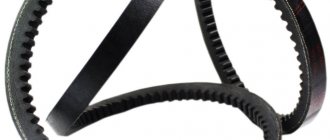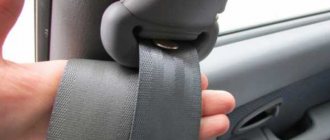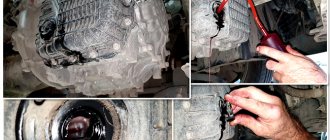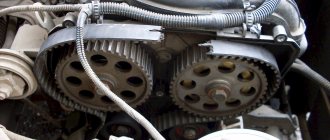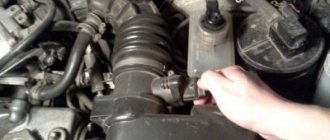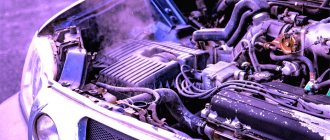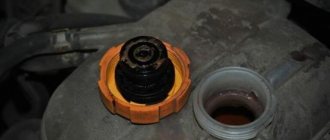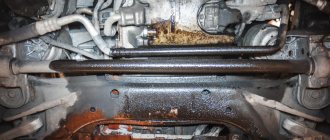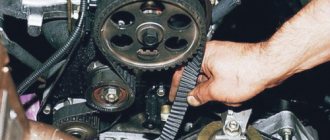The consequences of a broken timing belt depend on the design features of the engine and on the operating mode at the moment the valves meet the pistons. Let's look at the causes and consequences of a broken timing belt and tell you how to determine whether the valves are bent after a chain or timing belt has jumped.
On what engines does the valve not bend?
When the timing belt breaks, the reciprocating motion of the pistons is maintained, since the inertial force of the flywheel continues to rotate the crankshaft. But since there is no synchronization between the camshaft and the crankshaft, certain valves remain open as the pistons approach top dead center (TDC). This is how the valve plates “meet” with the pistons.
Why is it that on some engines, when the timing drive overshoots or breaks, the valve does not bend? The answer is in the special design of the pistons, which have special recesses. Due to the “counters”, there is a gap between the pistons at TDC and the fully open valves, which protects the parts from damage if the belt breaks. Look for information about the design features of your car’s engine model in the technical documentation.
For example, VAZ engines models 11186 and 11189, produced before 08/15/18, were “plug-in”, but after this date they were equipped with a modified piston group, eliminating the risk of pistons hitting the valves if the timing belt breaks.
There are rarely engines on which belt destruction during idle does not lead to bent valves (for example, 4A-GE from Toyota). Some manufacturers reduce the risk by making the pushrod material brittle. This solution is found on the 1.7 DR diesel engine from Opel, on which, when “meeting” at low speeds, the consequences are limited to only a few burst pushers. Such solutions are rare in global engine building practice, so on almost all diesel engines, a broken timing belt leads to bent valves.
What happens to the engine when the belt breaks?
When the car is running, the engine pistons move in a certain direction. The piston moves down during the intake stroke and rises during the exhaust stroke. When the cylinder block is at the top point, each valve must be closed.
When the timing belt is torn, the valve stops rotating and stops. However, the crankshaft rotates and the pistons are directed towards the open valves. After their meeting, the parts bend and become unusable. Regardless of whether the car is idling or in gear, the likelihood that the pistons will knock on the valves and bend them is quite high.
Causes of timing belt breakage
- Failure to comply with the service interval for replacing the timing belt.
- Too much or insufficient tension force.
- Contact with engine oil and other technical fluids on the working surface of the belt that reduces the engagement between the belt teeth and gears. Often in such cases, the belt first jumps 1-2 teeth, after which the engine loses power, starts poorly and may run unstably.
- Foreign objects getting under the belt. On most cars, the gas distribution mechanism drive is protected by a plastic casing. If the latter is damaged or incorrectly installed, dirt and small stones entering the working area will shorten the service life of the belt and rollers and can even cause a break.
- Water pump jammed. If the bypass or tension roller jams, the breakage does not occur instantly. Due to increased friction, the outer zone of the belt begins to heat up quickly. If you notice the smell of burnt rubber in time, listen to the extraneous sound from the timing drive and turn off the engine, you will be able to protect yourself from the costly consequences of a broken belt.
- Incorrect redistribution of force on the belt teeth. The reason should be sought in the misalignment of pulleys, gears, idler and tension rollers. Pay attention to the wear of the teeth of the crankshaft gear, camshaft, and fuel injection pump. At high mileage, due to wear on the gears, the belt teeth grind down, which reduces its service life and increases the risk of skipping/breaking.
- Failure to follow the recommendations for assembling the timing drive and handling the new belt.
- Defects in production or selection by the manufacturer of low-quality raw materials for the manufacture of a belt.
Signs of a broken timing belt
When the timing belt breaks, the engine stalls abruptly, and a loud bang is heard from the engine compartment (you can’t always hear it if the car is moving at high speed and low revs). The engine will not start after this. When cranked by the starter, the crankshaft rotates faster than usual. If the timing belt on a car breaks, the characteristic sound of the crankshaft rotating “idling” indicates a lack of compression in the cylinders.
Replacement
If the timing belt breaks (whether it’s a VAZ or a foreign car, it doesn’t matter), the first step is to install a new element. There are two reasons for the impending replacement:
- Natural wear and tear. Manufacturers recommend replacing the element at least once every 80 thousand kilometers. However, it is not uncommon for a belt to “nurse” for 150-200 thousand without deformation or whistling. But this does not mean that the replacement can be postponed indefinitely. This can lead to expensive repairs.
- Mechanical damage. The belt structure may be damaged due to gross errors during installation. This is a mismatch of marks, insufficient or excessive tension of the element. Also, the belt breaks (more often than not it simply falls off) during active driving “before the cut-off”, which is accompanied by sharp braking. If the car is “chipped” with a cutoff offset, there is a high probability of a belt break. Therefore, you should not often operate the car under heavy loads.
Consequences
On many engines, the consequences of a broken timing belt extend beyond bent valves. If trouble occurs while driving at high speed and high revs, the force of the impact may be sufficient to damage the pistons and disrupt the geometry of the valve liners. The consequences can be fully assessed only after the cylinder head is removed.
If the belt breaks at idle and it is not known for sure whether the valves on the engine are bent, you should install a new belt and measure the compression in the engine. The performance of each cylinder should not differ by more than 1.5-2 atm. To avoid further harm to the motor, use an endoscope with a rotating camera. It will not be possible to assess the degree of deformation of the valve stem, but you will be able to see marks on the pistons from the impact.
If, after installing a new belt, the engine starts, but runs unstable (troit), the valves are still bent and you should prepare for serious repairs.
In addition to a new timing kit (belt, rollers), it will be necessary to replace the intake/exhaust manifold gaskets and other seals that will not be suitable for reinstallation. During the repair, you should check the water pump, the condition of the valve seals and the piston group.
Video: Broken timing belt. What is the threat?
Possible costs and belt replacement procedure
The cost of one valve, excluding additional costs, averages a thousand rubles, and considering that all 16 may need to be replaced, you can imagine approximately how much the repair will cost.
In addition to the accompanying little things, you will need to purchase:
- A new belt, or a timing belt kit with a tensioner and idler pulley.
- Gaskets for intake and exhaust manifolds.
- Cylinder head gaskets and valve covers.
- Set of mounting bolts.
- Possibly the water pump (Pump), if wear is suspected.
The easiest way to perform the replacement operation is on a lift. To work you will need:
- a set of keys
- screwdriver
- locating pins for timing marks
- in some cases special tool.
To remove the old belt, follow the following action plan:
- Remove the timing case - secured with several bolts.
- Unscrew the crankcase protection bolts.
- Next, remove the compressor belt. To do this, dismantle it, remove the belt and install the compressor in place.
- Remove the alternator belt.
- To disconnect all contacts, remove the terminal from the battery.
- Unscrew the mounting bolts from the engine and remove the generator, terminal and pump pulley, remembering to first remove the bolts holding them.
- It may be necessary to remove the engine mount.
- Remove the protective cover from the timing belt
Now proceed with the actual replacement, for which you will need to remove the timing pulley covers and pull out the old timing belt. Put a new one in its place and tighten the tensioner. If the rollers become unusable, they should also be replaced. Next, assemble the structure in reverse order. Keep in mind that each car brand has its own characteristics of removing and installing the timing belt, however, in general they are very similar.
Belt Drive Condition Assessment
The average service life of a timing belt is 50-70 thousand km. The exact replacement intervals are indicated in the repair and operating manual for your car. In situations where, after purchasing a car, there is no reliable information about the timing of previous maintenance of the timing drive, the need for urgent replacement can be understood by the following signs:
- Cracks in the belt base.
- Wear of the upper edge of the teeth.
- Oil on the timing belt.
- Noise from the pump, tension or idler pulley.
- Worn belt edges.
How to avoid timing belt breakage?
- Follow the replacement periods prescribed by the manufacturer.
- Once every 15-20 thousand km. inspect the gas distribution mechanism drive for oil fogging and antifreeze.
- On runs over 150 thousand km. Whenever you replace the timing belt, inspect the sprockets of the camshafts, crankshaft and injection pump for critical tooth wear.
- Install a high-quality timing kit from a trusted manufacturer.
Many reputable companies allow you to verify the authenticity of their kits. To do this, the packaging has holographic protection and/or a code that must be entered into the decoder on the manufacturer’s website. There is a hologram, after scanning which the buyer receives a notification about the authenticity of the purchased product.
What to pay attention to during the renovation process?
The success of the repair largely depends on the correct troubleshooting of the gas distribution mechanism parts and the cylinder-piston group. If the timing belt breaks, pay special attention to measuring the protrusion of the pistons and checking the geometry of the valves. Check the condition of the valve guides and the chamfers of the valve seats in the cylinder head. Requirements for serviceable valves:
- the diameter of the valve stem is the same along the entire length of the stem;
- plate runout no more than 0.025 mm;
- the beating of the rod over a length of 10 cm does not exceed 0.015 mm;
- The valve chamfer has no deep damage.
To check the runout of the rod and disc, the valve is mounted on a pair of V-shaped stops. The measurement is carried out with a dial indicator mounted on a special stand.
What does this lead to?
If your timing belt breaks, the consequences can vary. As we said earlier, it all depends on the design of the power unit. Here you can be guided by the principle “the simpler the motor, the more reliable it is.” When the engine is in the TDC position, the valve does not reach the bottom of the piston, nothing will happen. In this case, if the timing belt breaks, only the purchase of a new product can be included in the expense item. All valves will remain intact without damage to the stem geometry.
Rules for handling a new timing drive kit
- Do not roll the belt into rings or allow the timing belt to bend or twist, as this may damage the elastic cord.
- Some car manufacturers have developed an installation tool for servicing the timing drive. The use of any other tool can lead to a shift in the timing of the gas distribution mechanism and damage to the belt. An error with setting the marks is fraught with unstable engine operation, loss of power, and even “meeting” of the valves with the pistons.
- Never reinstall a used belt.
Modern timing belts use fiberglass cord. It has a large margin of tensile strength, which entails a loss in elasticity. Therefore, the belt must not be bent or broken. This can damage the elastic cord and shorten the service life of the belt.
In what order should repairs be carried out?
First of all, you should provide access to the timing belt and make sure that it is really torn. Next, you need to investigate how serious the damage is. This requires dismantling the cylinder head. It is necessary to check the condition of the valves, replace if necessary and grind in the damaged valve.
After eliminating the consequences of the break, it is necessary to install the timing belt, guided by special requirements.
Remember, it is easier to prevent this malfunction than to eliminate its consequences!

